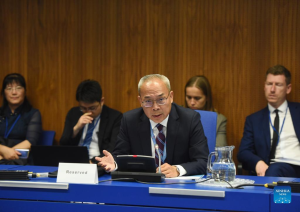NEW YORK, Aug. 1 (Xinhua) — The Biden administration’s curbs on chip sales to China likely have impeded revenue growth of U.S. chips companies to some extent, a U.S. expert has said.
“The U.S. chips companies, like any companies, are very interested in expanding market share, and selling to the China market is very important since China is now the biggest consumer of chips in the world,” Victor Shih, associate professor of political science who also heads the 21st Century China Center at the School of Global Policy and Strategy with the University of California San Diego, told Xinhua in a recent interview.

On July 17, CEOs from three major semiconductor giants, including Intel, Qualcomm and NVIDIA, met with top officials from the Biden administration. They urged the government to exercise restraint in implementing further restrictions on chip exports to China, pause and assess the current policies’ impact on the industry.
A recent Bloomberg News report indicates that chip equipment manufacturers like Applied Materials Inc. have experienced significant revenue losses since the Biden administration implemented the chip restrictions. They were compelled to slash billions of dollars from its revenue projections.
With the increasing complexity of chips, the expenses related to their development have surged significantly. According to a report by the Semiconductor Industry Association, semiconductor sales worldwide were 556 billion U.S. dollars in 2021.
The meeting between chip industry executives and top Biden administration officials occurred amid growing speculation that the administration will soon extend restrictions on selling certain chips and semiconductor manufacturing equipment to China.
One central argument made by the chip industry is that they have greatly benefited from chip sales to China, their largest single market. The companies argue that revenue drops resulting from chip sales restrictions will harm their ability to further invest in R&D.
The Biden administration has repeatedly cited national security concerns to justify its stance. The administration pushed through the “CHIPS and Science Act of 2022” last October, allocating 280 billion dollars to boost domestic microchip production in the United States.
On July 25, the Semiconductor Industry Association and Oxford Economics released a joint report stating that approximately 67,000 positions in the U.S. semiconductor industry, including roles for technicians, computer scientists and engineers, are projected to remain vacant by 2030.
Besides the shortfall of skilled workforce, the high cost is another hurdle for the industry. “The higher cost basis in the U.S. will not change in the short run. In the medium term, it remains unclear whether the U.S. can set up an apprenticeship program to train sufficient numbers of technicians for semiconductor fabs,” said Shih.
The Semiconductor Industry Association revealed that the 10-year total cost of ownership of a new lab in the United States is 30-50 percent higher than in East Asian economies.
On the same day that the chip industry CEOs sat down with the Biden officials, the association released a statement, warning that any steps to further “impose overly broad, ambiguous, and at times unilateral restrictions risk diminishing the U.S. semiconductor industry’s competitiveness, disrupting supply chains, causing significant market uncertainty, and prompting continued escalatory retaliation by China.”
If the restrictions continue, “the segmentation of the global semi market potentially will create very capable Chinese chips competitors to U.S. companies since Chinese buyers now have no choice but to buy from domestic chips makers, giving them a large captive market,” Shih said.
“A balance between national security concerns and commercial concerns is possible. Not every chip sold by U.S. companies is cutting edge or has national security relevance. In those cases, the U.S. government should show some flexibility,” said Shih.

